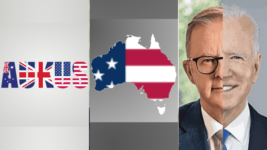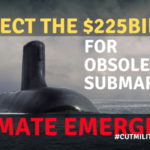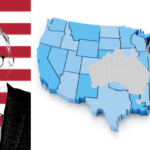A Lack of AUKUS Subs May Cause Domestic Frowns, But Uncle Sam Is None Too Fazed

Australia was confronted with the news that the first of three second-hand Virginia class nuclear-powered submarines, we are is supposed to receive in 2032, may not be forthcoming just prior to Thursday’s one year anniversary of the 2023 San Diego unveiling of the AUKUS optimal pathway.
Announced by former PM Scott Morrison in September 2021, and since championed by current PM Anthony Albanese, AUKUS is a pact involving us, the US and the UK that’s concerned with rising tensions in the Indo Pacific, and phase one involves us acquiring eight nuclear-powered subs.
Concerns about Australia’s slated submarines ever materialising are not new. Yet, these fears were assuaged in December, when the Biden administration passed its national defence bill for 2024, which facilitates the transfer of three Virginia class boats to Australia in the 2030s.
The issue that arose this week is that the Pentagon released its 2025 fiscal year budget, and it only sets aside funding to build one Virigina sub that year, which effects the AUKUS deal, as the US had promised to lift production from around 1.3 boats a year to 2.3 in order to meet its requirements.
But while local ministers were fretting, the US had one of its nuclear-powered submarines (SSN) docked in Perth, which signalled that regardless of whether Australia acquires any nuclear-powered boats, the other AUKUS trappings, which involve US inroads onto this continent, will proceed.
Disappearing boats
Under AUKUS, Australia is supposed to acquire its first of three used Virginia-class SSNs over the 2030s. And these are to bridge our capability gap, as we don’t own submarines with the capacity to attack China, as it’s foreseen Australia will be fighting alongside the US in a future war on China.
US congressperson Joe Courtney told the Herald that the reason for this development is the US is struggling with shipbuilding capacity in regard to its own fleet. And the concern for this country is that whilst the US Navy attempts to overcome its shortage, Australia’s need will be deprioritised.
The Democrat politician further stated that the decrease in production in the coming fiscal year “will remove one more attack submarine from a fleet that is already 17 submarines below the navy’s long stated requirement of 66”.
So, the US needs to produce 18 more submarines by 2032 in order to hand over one of its old boats to us. And on coming to the first chance to budget for the optimal pathway, after having passed laws permitting the transfer to occur, the deal is now running at least a year behind schedule.
“When the US passed the law to set up AUKUS they put in kill switches, one of which allowed the US to not transfer the submarines if doing so would ‘degrade the US undersea capabilities’,” explained Greens Senator David Shoebridge on X as the news was breaking.
Submarines aplenty
Australian defence industry minister Pat Conroy said federal Labor is confident that the Virginia submarines will appear, as his government was going into damage control.
However, the White House is likely unfazed about this issue, and the truth of the matter is, it’s probably been aware of it for some time.
As the USS Annapolis submarine docked over in Western Australia reveals, there will likely be no issues with the rest of AUKUS pillar 1 coming to fruition, and it’s those extras that would be of more concern for the Pentagon, as it’s setting up yet another force posture initiative on this continent.
Liberal defence spokesperson Andrew Hastie confirmed this week that construction at HMAS Stirling is set to commence next year. And this is in preparation for the 2027 establishment of Submarine Rotational Force-West: a joint permanent US-UK nuclear-powered submarine presence in WA.
Indeed, it came to light late last year, that SRF-West will involve 700 US Army personnel and their families being stationed in Western Australia.
This US-UK submarine force is designed to fill this nation’s capability gap prior to its acquisition of the now-threatened Virginia class boats, so it would be no stretch of the imagination to consider that if the second-hand subs don’t materialise, the US submarines will be on hand to cover us.
In fact, this new US-UK presence in the west of the continent may also serve as an alternative to the five British-designed AUKUS SSN that are currently slated to be built in Adelaide over the coming decades.
And the Australian state respects the Pentagon’s warhead ambiguity policy, which means that any US military vehicles, vessels or planes stationed within Australia’s jurisdiction could be carrying nuclear weapons for all our government knows.
Nuclear waste covered too
Shoebridge explained over X on Wednesday that he was about to enter a hearing to decide on where the AUKUS powers can dump their nuclear waste on local unceded First Nations land.
Local waste dumps are being considered, as the US and the UK don’t even have permanent radioactive waste dumps themselves.
The waste to be dumped here is said to have a low-level radioactivity. However, as former Senator Rex Patrick has pointed out, at the end of their shelf lives, SSNs produce high-level radioactive waste that will need to be stored somewhere underground forever.
And tabled in November, the Australian Naval Nuclear Power Safety Bill 2023 permits the construction of the AUKUS SSNs, a plant to maintain their nuclear power, and a fair way into the bill’s explanatory memorandum, one finds “a radioactive waste management facility” on the cards.
Footing the bill
This nation is also about to invest US$3 billion into the US submarine industrial base, so it can expand capacity, which entails an initial $2 billion contribution next year, followed by $100 million annually over 2026 through to 2033.
And it’s unlikely Washington will be letting this nation off the hook in terms of making these payments, as Canberra will appreciate that the US and the UK submarines will be covering our bases from 2027 onwards.
And for its part, the Pentagon has budgeted to contribute US$4 billion into its own submarine industry next year, with an as extra $11 billion poured in over the following five years.
“Australia don’t become America”
The removal of the Virginia subs, and even the AUKUS boats, from the agreement, would, in fact, be in keeping with business as usual, in terms of the 2014 Force Posture Agreement, officially signed off on by ex-Liberal PM Abbott, while former Labor PM Gillard greenlighted the arrangement in 2011.
Part of the Obama administration’s “pivot to Asia”, the force posture agreements see 2,500 US Marines stationed in the Northern Territory. It promotes increasing interoperability between air forces. And it allows the US unimpeded access to dozens of “agreed to facilities and areas”.
These agreed bases remain classified. However, as the recent overhaul of RAAF Base Tindall in the NT reveals, when the US decides to upgrade a local base, the Pentagon takes full control of it. And Tindall has been fitted with storage for six US B-52 bombers that may be carrying nuclear warheads.
Growing US incursions onto this continent have been criticised since local US bases were established at Pine Gap and North West Point in the 1960s.
And the final cherry on the cake in terms of further importation of US sovereignty, is that the US legislation that facilitated US ability to transfer Virginia-class subs to Australia, also establishes our nation as a US domestic military source, allowing it privileged access to critical minerals, like lithium.
So, this latest development in the AUKUS saga would appear to put the heralded Australian submarines in jeopardy, but it continues to be the optimal path forward in terms of the US heightening its local presence, as well as in opening up this land to exploit for local resources.







